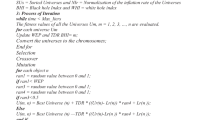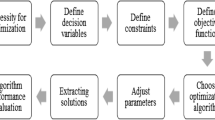Abstract
The environmental water demand of the Mahabad River in the Urmia Lake basin in Iran was first estimated, using the flow duration curve shifting method (FDC Shifting) in this study. Secondly, the optimal operating model of the reservoir was developed with the goals of decreasing the deficiencies and considering the downstream demands of the reservoir, especially the environmental water demands by employing the simulated annealing (SA) and non-linear programming (NLP) methods. The results of the SA algorithm were compared with those of the NLP model with the indices of reliability, resiliency velocity, vulnerability, and sustainability. Then, the optimum released water values in the current month, the optimum water storage values in the reservoir, reservoir inflows and monthly demands were considered as inputs of the M5 tree model, and the optimum values of released water in the next month were considered as outputs of the M5 model. Finally, the optimum operation rules from the reservoir were developed in the form of if-then linear rules for future uses. One of the main advantages of the M5 tree model is to present two operation rules as if-then rules for all the operating periods with relatively acceptable accuracy. The results showed that the SA-M5 tree model, as a method of data mining, can extract the operation rules with relatively high accuracy.














Similar content being viewed by others
References
Alagoz SH, Yasi M (2018) Urmia Lake environmental water right from Gadar River. Journal of Sigma 36(3):861–870
Alberg D, Last M, Kandle A (2012) Knowledge discovery in data streams with regression tree methods. Journal of Wires Data Mining Knowledge Discovery 2(1):69–78
Allawi MF, Jaafar O, Hamzah FM, Abdullah SMS, El-shafie A (2018) Review on applications of artificial intelligence methods for dam and reservoir-hydro-environment models. Journal of Environmental Science and Pollution Research 25(14):13446–13469
Asadieh B, Afshar A (2019) Optimization of water-supply and hydropower reservoir operation using the charged system search algorithm. J Hydrol 6(1):5
Azarnivand A, Hashemi-Madani FS, Banihabib ME (2015) Extended fuzzy analytic hierarchy process approach in water and environmental management (case study: Lake Urmia Basin, Iran). Journal of Environmental earth sciences 73(1):13–26
Bahrami M, Bozorg Haddad O, Chu X (2017) Application of cat swarm optimization algorithm for optimal reservoir operation. J Irrig Drain Eng 144(1):04017057
Bozorg Haddad O, Aboutalebi M, Ashofteh PS, Loáiciga HA (2018) Real-time reservoir operation using data mining techniques. Journal of Environmental monitoring and assessment 190(10):594
Brooke A, Kendrick D, Mearaus A (1996) GAMS, a user guide. GAMS Development Corporation, Washington
Ehteram M, Karami H, Mousavi SF, El-Shafie A, Amini Z (2017) Optimizing dam and reservoirs operation based model utilizing shark algorithm approach. Journal of Knowledge-Based Systems 122:26–38
Hashimoto T, Stedinger JR, Loucks DP (1982) Reliability, resiliency, and vulnerability criteria for water resource system performance evaluation. J Water Resour Res 18(1):14–20
Hassanzadeh E, Zarghami M, Hassanzadeh Y (2012) Determining the main factors in declining the Urmia Lake level by using system dynamics modeling. J Water Resour Manag 26(1):129–145
Henderson D, Jacobson SH, Johnson AW (2006) The theory and practice of simulated annealing. In: Handbook of metaheuristics. Springer, Boston, MA, pp 287–319
Jager HI, Smith BT (2008) Sustainable reservoir operation: can we generate hydropower and preserve ecosystem values? Journal of River research and Applications 24(3):340–352
Jia W, Dong Z, Duan C, Ni X, Zhu Z (2019) Ecological reservoir operation based on DFM and improved PA-DDS algorithm: A case study in Jinsha river, China. Journal of Human and Ecological Risk Assessment: An International Journal 1–19
Jothiprakash V, Kote AS (2010) Effect of pruning and smoothing while using M5 model tree technique for reservoir inflow prediction. J Hydrol Eng 16(7):563–574
Kangrang A, Chaiyapoom W, Homwuttiwong S (2012) An application of simulated annealing algorithm with reservoir simulation model to improve reservoir rule curves. J Sci Technol MSU 31(5):578–584
Karimi SS, Yasi M, Eslamian S (2012) Use of hydrological methods for assessment of environmental flow in a river reach. Int J Environ Sci Technol 9(3):549–558
Khodabakhshi F, Ghirian AR, Khakzad N (2009) Applying simulated annealing for optimal operation of multi-reservoir systems. American Journal of Engineering and applied Sciences 2(1):80–87
Kirkpatrick S, Gelatt CD, Vecchi MP (1982) Optimization by simulated annealing. Journal of Science 220:671–680
Kumar DN, Reddy MJ (2006) Ant colony optimization for multi-purpose reservoir operation. J Water Resour Manag 20(6):879–898
Kumar SAR, Goyal MK, Ojha CSP, Singh RD, Swamee PK, Nema RK (2013) Application of ANN, fuzzy logic and decision tree algorithms for the development of reservoir operating rules. Journal of Water Resource Management 27:911–925
Li XG, Wei X (2008) An improved genetic algorithm-simulated annealing hybrid algorithm for the optimization of multiple reservoirs. Journal of Water Resource Management 22(8):1031–1049
Loucks DP, Stedinger JR, Haith DA (1981) Water resource systems planning and analysis, 1st edn. Prentice Hall, Englewood Cliffs, New York
Ma L, Wang H, Lu B, Qi C (2018) Application of strongly constrained space particle swarm optimization to optimal operation of a reservoir system. Journal of Sustainability 10(12):4445
Mehr AD, Jabarnejad M, Nourani V (2019) Pareto-optimal MPSA-MGGP: a new gene-annealing model for monthly rainfall forecasting. J Hydrol 571:406–415
Oyebode OK, Otieno FAO, Adeyemo J (2014) Review of three data-driven modelling techniques for hydrological modelling and forecasting. Journal of Fresenius Environmental Bulletin 23(7):1443–1454
Pal M, Singh NK, Tiwari NK (2012) M5 model tree for pier scour prediction using field dataset. KSCE J Civ Eng 16(6):1079–1084
Quinlan JR (1992) Learning with continuous classes. In 5th Australian Joint Conference on Artificial Intelligence 92: 343–348
Sattari MT, Apaydin H, Ozturk F, Baykal N (2012) Application of data mining approach to derive operation rules for the Eleviyan irrigation reservoir. Journal of Lake And Reservoir Management 28(2):142–152
Smakhtin VU, Anputhas M (2006) An assessment of environmental flow requirements of Indian river basins. IWMI Research Report 107, International Water Management Institute, Colombo, Sri Lanka
Solomatine DP, Ostfeld A (2008) Data-driven modelling: some past experiences and new approaches. J Hydroinf 10(1):3–22
Sudha V, Ambujam NK, Venugopal K (2006) A data mining approach for deriving irrigation reservoir operating rules. Conference on water observation and information system for decision support 23–26 may 2006. Orhid, Macedonia
Teegavarapu RSV, Simonovic SP (2002) Optimal operation of reservoir systems using simulated annealing. J Water Resour Manag 16(5):401–428
Wang J, Cheng Z, Ersoy OK, Zhang M, Sun K, Bi Y (2019) Improvement and application of chicken swarm optimization for constrained optimization. Journal of IEEE Access 7:58053–58072
Witten IH, Frank E (1999) Data mining: practical machine learning tools and techniques with Java implementations. Morgan Kaufmann, San Francisco
Xu Y, Mei Y (2018) A modified water cycle algorithm for long-term multi-reservoir optimization. Journal of Applied Soft Computing 71:317–332
Zhan SH, Lin J, Zhang ZJ, Zhong YW (2016) List-based simulated annealing algorithm for traveling salesman problem. Journal of Computational Intelligence and Neuroscience 5
Author information
Authors and Affiliations
Corresponding author
Additional information
Publisher’s Note
Springer Nature remains neutral with regard to jurisdictional claims in published maps and institutional affiliations.
Highlights
• The environmental water demand is obtained by the FDC Shifting method.
• A metaheuristic algorithm (SA) and a classical method (NLP) are applied to optimize the reservoir operation.
• The SA algorithm has good performance in comparison with the NLP method.
• The combination of SA and M5 tree model is proposed.
• The results of SA-M5 have good performance in the optimizing reservoir operation.
Rights and permissions
About this article
Cite this article
Rouzegari, N., Hassanzadeh, Y. & Sattari, M.T. Using the Hybrid Simulated Annealing-M5 Tree Algorithms to Extract the If-Then Operation Rules in a Single Reservoir. Water Resour Manage 33, 3655–3672 (2019). https://doi.org/10.1007/s11269-019-02326-4
Received:
Accepted:
Published:
Issue Date:
DOI: https://doi.org/10.1007/s11269-019-02326-4




